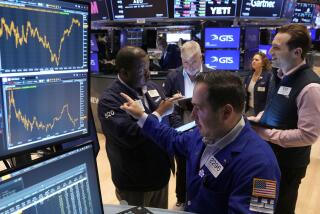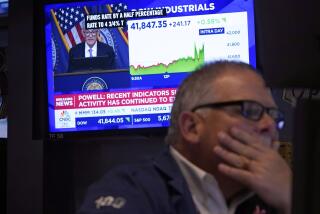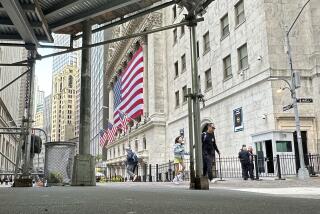U.S. futures and global stock markets fall after Fed rate cut
BEIJING — Global stock markets and U.S. futures fell Monday after central bank moves to shore up economic growth failed to dispel investors’ fears over antivirus controls that are shutting down global business and travel.
There were no glimmers of optimism: Paris tumbled 9% shortly after the open, London sank 7% and Frankfurt gave up 7.5%. In Asian trading, Sydney’s benchmark plunged 9.7%, Hong Kong’s Hang Seng lost 3.4% and India shed 5.9%.
Tokyo closed 2.5% lower after Japan’s central bank expanded asset purchases to inject money into the economy and promised no-interest loans to help companies cope with the crisis. Chinese shares fell after Beijing reported consumer spending and factory output were even worse than expected.
On Wall Street, futures for the benchmark S&P 500 index and Dow Jones industrial average were off nearly 5% following Sunday’s emergency rate cut by the Federal Reserve.
The Fed cut its key rate by a full percentage point — to a range between zero and 0.25%. The central bank said it would stay there until it feels confident the economy can survive a near-shutdown of activity in the United States.
“Despite whipping out the big guns,” the Fed’s action is “falling short of being the decisive backstop for markets,” said Vishnu Varathan of Mizuho Bank in a report. “Markets might have perceived the Fed’s response as panic, feeding into its own fears.”
The Fed action came as Western governments expanded travel curbs and closed more public facilities, raising the cost of efforts to contain the outbreak that has infected nearly 170,000 people worldwide. China, where the coronavirus emerged in December, accounts for about half of those, but a dozen other countries have more than 1,000 cases each.
London’s benchmark FTSE 100 index lost 6.9% to 4,995.46. Frankfurt’s DAX shed 7.6% to 8,532.05. The CAC 40 in France sank 8.8% to 3,755.99.
The S&P 500 future was down 4.8% and the Dow’s was off 4.6%.
The S&P 500 future fell 5% on Sunday night following the Fed’s announcement, triggering a temporary trading halt.
The Fed said it also will buy at least $500 billion of Treasury securities and $200 billion of mortgage-backed securities. This amounts to an effort to ease market disruptions that have made it harder for banks and large investors to sell Treasury bills and to keep longer-term borrowing rates down.
That followed a dizzying week in which the Dow twice fell by more than 2,000 points and also recorded its biggest point gain ever — 1,985 points on Friday. The bull market that began in 2009 in the depths of the financial crisis came to an end.
In Sydney, the S&P-ASX 200 fell to 5,002.00. Hong Kong’s Hang Seng tumbled to 23,063.57. In India, the Sensex retreated 6.6% to 31,812.12.
The Shanghai Composite Index declined 3.4% to 2,789.25 after the government reported retail sales fell 20.5% from a year ago in January and February after shopping malls and other businesses were closed. Factory output declined by a record 13.5% after the Lunar New Year holiday was extended to keep manufacturing workers at home.
The figures were even bleaker than economists expected. Some cut their forecasts for the world’s second-largest economy. ING said this year’s growth might fall as low as 3.6%, the weakest since at least the 1970s.
The Bank of Japan’s decision to expand purchases of stocks, corporate bonds and other assets viewed as riskier than Japanese government bonds fell flat.
The Nikkei 225 in Tokyo sank to 17,002.04 while Seoul’s Kospi lost 3.2% to 1,714.86.
The Bank of Japan also announced plans to provide up to 8 trillion yen ($75 billion) in no-interest, one-year loans to companies that face cash crunches.
Bank Gov. Haruhiko Kuroda has pledged to do whatever is needed to help buttress an economy that contracted by 7.1% in the last quarter, even before the virus hit.
Over the weekend, Spain followed Italy’s lead in imposing nationwide curbs that will allow its 46 million people to leave home only to go to work, to buy food and medicine or on errands to care for the young and elderly.
In the Philippines, soldiers and police sealed off the crowded capital, Manila, from most domestic travelers.
New York City announced it will shut down the largest U.S. public school system as early as Tuesday, sending more than 1.1 million children home. Governors in California, Illinois and Ohio told all bars and restaurants to close or reduce their number of customers.
For most people, the coronavirus causes only mild or moderate symptoms, such as fever and cough, and those with mild illness recover in about two weeks. But severe illness including pneumonia can occur, especially in the elderly and people with existing health problems, and recovery could take six weeks in such cases.
There are 169,000 confirmed cases of the virus worldwide, according to a tally by Johns Hopkins University. Most of the world’s 77,000 recovered patients are in China.
Experts expect the disruptions to travel and even to daily life to last for weeks, possibly months.
Brent crude lost $2.10 to $31.84 per barrel in London. Benchmark U.S. crude tumbled $1.29 to $30.44 per barrel in electronic trading on the New York Mercantile Exchange.
In currency markets, the dollar declined to 106.35 yen from Friday’s 107.91. The euro gained to $1.1196 from $1.1105.
JPMorgan Chase now is forecasting the U.S. economy will shrink at a 2% annual rate in the current quarter and 3% in the April-June quarter.
The Fed’s decision to act before a meeting scheduled for midweek indicated its policymakers felt they needed to move immediately to shore up investor confidence. Most market watchers expect more volatility ahead because the number of U.S. virus cases is rising and more industries face a downturn.
United Airlines said it needs to cut flying capacity by 50% in April and May and expects the cuts to extend into the summer travel season. American Airlines said it is cutting international flying 75%.
Walmart is limiting hours to ensure stores can keep sought-after items such as hand sanitizer in stock. Late Friday, Apple said it was closing all retail stores outside of China.
The magnitude of the central bank moves indicated to some analysts that Chairman Jerome H. Powell and other members of the Fed were worried about the health of the financial system. But others noted the Fed was just reacting to signs the situation in Europe and the U.S. was only getting worse.
“The Fed’s actions were very bold and it does appear to have spooked the markets,” said Nate Thooft, head of global asset allocation at Manulife Investment Management.
“Markets were going to be spooked anyway due to the scale of the shutdowns across the U.S. and sobering implications of a $20-trillion economy that is about to grind down to a crawl,” said Yung-yu Ma, chief investment strategist at BMO Wealth Management.
“Also, developments in Europe are raising the prospect that what was just a week ago considered ‘worst case’ might be closer to ‘base case’ for the U.S.,” Ma said. “Big picture, the Fed’s actions are all positive.”
More to Read
Inside the business of entertainment
The Wide Shot brings you news, analysis and insights on everything from streaming wars to production — and what it all means for the future.
You may occasionally receive promotional content from the Los Angeles Times.










